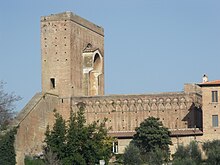Porta Pispini
The Porta Pispini (also called Porta dei Pispini , formerly Porta San Viene ) is a city gate in Siena and part of the city walls of Siena .
location
The city gate Porta Pispini is located at the southwest end of Siena at the end of Via Pispini (Via dei Pispini). The road that continues after the city gate is called Via Aretina (here coincides with Via Lauretana ), named after the route to Arezzo . The historical route led via Asciano , Rapolano Terme and Monte San Savino to Arezzo and finally ended in Fano on the Adriatic coast .
The city gate is located in the third third of the city, Terzo di San Martino, in the Contrada Nicchio (shell) and is located in the city wall between the Porta Ovile (also called Porta d'Ovile or Porta a Ovile ) and the Porta Romana .
construction
The Porta Pispini is a chamber gate and has a total of three lockable gates, with the main tower (Torrione) in the middle of the two front gates. The main tower itself has two different locking mechanisms, one of which acts as a portcullis (Saracinesca).
history
According to legend, the remains of St. Sant'Ansano , today the patron saint of the city of Siena, were erected on February 6, 1107 after his martyrdom near Monteaperti (today part of Castelnuovo Berardenga ) in 304 through a specially built triumphal arch at the site of the current city gate brought to town. Hence the first name of the gate was Porta San Viene (San Viene, after Il Santo viene - the saint comes). Initially the gate was probably dedicated to Sant'Eugenia and was also documented as Porta Santa Eugenia around 1310 . The city gate gained historical importance for Siena when the Senese army, led by Provenzano Salvani, marched through the city gate on September 3, 1260, only to defeat the troops from Florence the next day in the battle of Montaperti . The construction of the current gate was started in 1326 by the architect Minuccio di Rinaldo and had the purpose of connecting the suburbs (Borghi) around the Abbadia Nuova abbey to the city center with the extension of the city walls. The construction took place as part of the fourth city wall extension. The city gate was built before the completion of the city walls in this section. It is named after the nearby Fontana dei Pispinelli (fountain). This was documented since 1395 and was replaced by a new fountain in 1467 and 1534, the name being transferred to the city gate only after 1534.
Fortino Peruzziano
The bastion , which is almost adjacent to the city gate, was built just north of the gate between 1527 and 1529 by Baldassare Peruzzi . Today it is the Peruzzi bastion that has been best preserved.
art
- The inside of the Torrione contains a fresco by Sodoma ( La natività del nostro Signore ), which was created in 1531 and is almost completely destroyed today. The few remains of the fresco are now on the inside of the facade of the Basilica di San Francesco . The fresco also contained a self-portrait of Sodoma.
- In the interior in a tabernacle there is a fresco of a Madonna by Sano di Pietro .
photos
literature
- Mario Ascheri (Ed.): Siena e la Città-Stato del medioevo italiano. Betti Editrice, Siena 2004, ISBN 978-88-7576-011-3
- Ettore Pellegrini: Fortificare con arte. Mura, porte e fortezze di Siena nella Storia. Betti Editrice, Siena 2012, ISBN 978-88-7576-228-5
- Augusto Ricci: Pispini. Storia di un rione. Edizioni Cantagalli, Siena 1979
- Piero Torriti: Tutta Siena. Contrada per Contrada. Edizioni Bonechi, Florence 2004, ISBN 88-7204-456-1
- Touring Club Italiano : Toscana. Milan 2003, ISBN 978-88-365-2767-0
Web links
Individual evidence
- ↑ Ricci, p. 154
- ↑ Ricci p. 153
- ^ TCI and Comune di Siena
- ^ Giovanni Antonio Pecci: Memorie storico-critiche della città di Siena. Vol. 3, Siena 1758, p. 13
- ↑ a b c d e Pellegrini
- ↑ Luigi Pruneti: La Toscana dei Misteri. Editrice Le Lettere, Florence 2005, ISBN 88-7166-852-9 , p. 173.
- ↑ Ascheri p. 24.
- ↑ a b Torriti p. 344
- ↑ ilpalio.org on the Fontana dei Pispini , accessed on August 31, 2013 (ital.)
- ↑ Ricci p. 153
Coordinates: 43 ° 19 ′ 2.3 ″ N , 11 ° 20 ′ 33.2 ″ E



